Wednesday night saw Roma face Feyenoord in the inaugural UEFA Europa Conference League Final at the Arena Kombëtare in Tirana, Albania. The Giallorossi were seeking to win their first trophy in 14 years, since the 2007/08 Coppa Italia, and a first European trophy since lifting the Fairs Cup in the early 60s. Feyenoord are the last Dutch team to have lifted a European title, winning the UEFA Cup in 2002. Arne Slot aimed to overcome a resilient Roma side to deliver silverware in his first season at the club.
The winners of this tournament would secure a place in next season’s Europa League, a competition both teams had already qualified for by way of their domestic finishes. Roma defender Gianluca Mancini admitted his side were labelling it the “cup of jokes” at the start of the campaign, but after playing 14 games to get there he was calling the final the most important game of his career. Jose Mourinho’s reaction at the final whistle against Leicester City, bursting into tears, demonstrates how much was riding on this game.
The match was cagey during the first 15-20 minutes, as finals tend to be, with both teams unable to generate any sort of rhythm and chances few and far between. Mourinho lost Henrikh Mkhitaryan after a quarter of an hour when the muscle tear he’d spent the last month rehabbing opened up again. Nicolò Zaniolo broke the deadlock in the 32nd minute after a cleverly lofted finish. Despite intense second-half pressure from their opponents – Gernot Trauner hit the post at the beginning of the half and Rui Patricio pushed a stinging shot from Tyrell Malacia onto the bar – Roma dug deep and managed to hold on to their narrow lead.
This gifted the club its first European honour since Giacomo Losi held aloft the Inter-Cities Fairs Cup in 1961 after defeating Birmingham City. It has ended the wait for silverware, not just for Roma but for Italy, who last celebrated a European trophy when Mourinho won the Champions League with Inter Milan 12 years ago.
“The special one” became the first manager to win a European trophy with four different clubs and took his overall tally to five major European titles.
This tactical analysis will break down some of the key tactics we saw in Wednesday’s final.
Lineups
Roma lined up in their customary 3-4-2-1 formation that Mourinho has deployed during the second half of the season. During the course of the match, the system shifted to a 3-4-1-2 with Zaniolo joining Abraham up front and Pellegrini dropping into midfield. Smalling played in the centre of a back three while Karsdorp and Zalewski occupied the wing-back slots. Leonardo Spinazzola started on the bench.
Feyenoord have been extremely consistent with their 4-2-3-1, using it 84% of the time in 2021/22. They boast the best attacking record in the Conference League, led by striker Cyriel Dessers with 10 goals. Tammy Abraham is second on the list with nine.
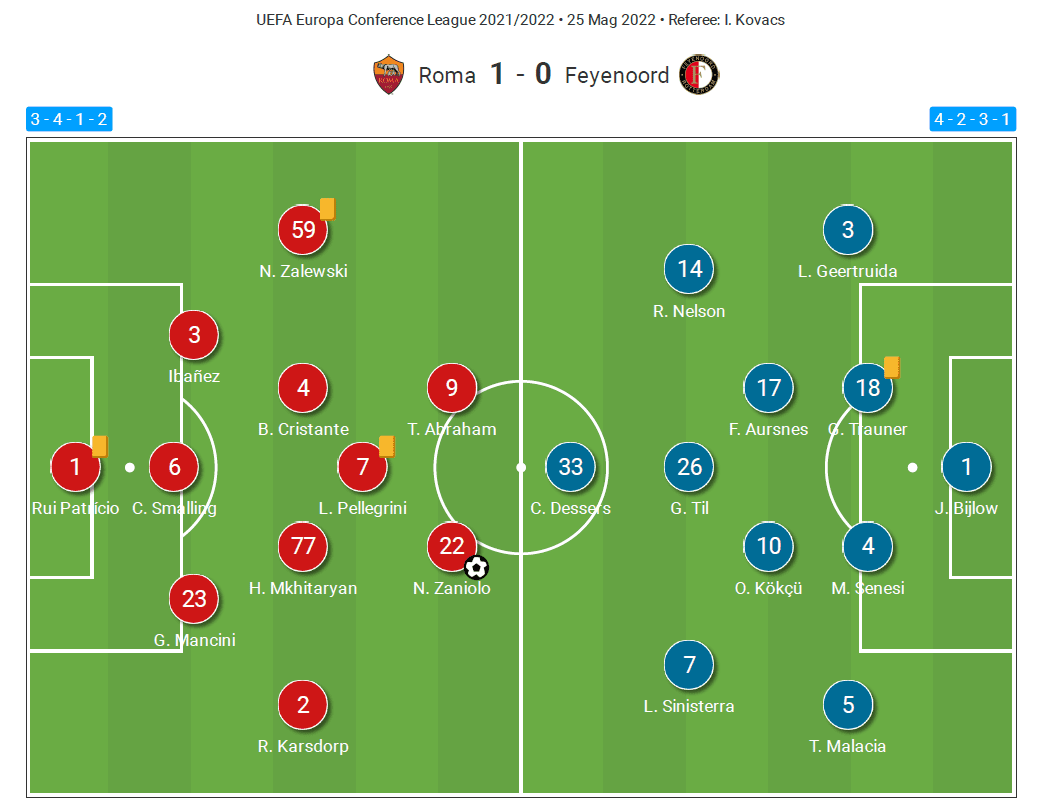
The formations for this analysis are viewed clearly below. Pellegrini had license to go past the front two but also supported Cristante and Mkhitaryan (and later Sergio) in midfield. Geertruida drifted inside to act as an inverted right-back.
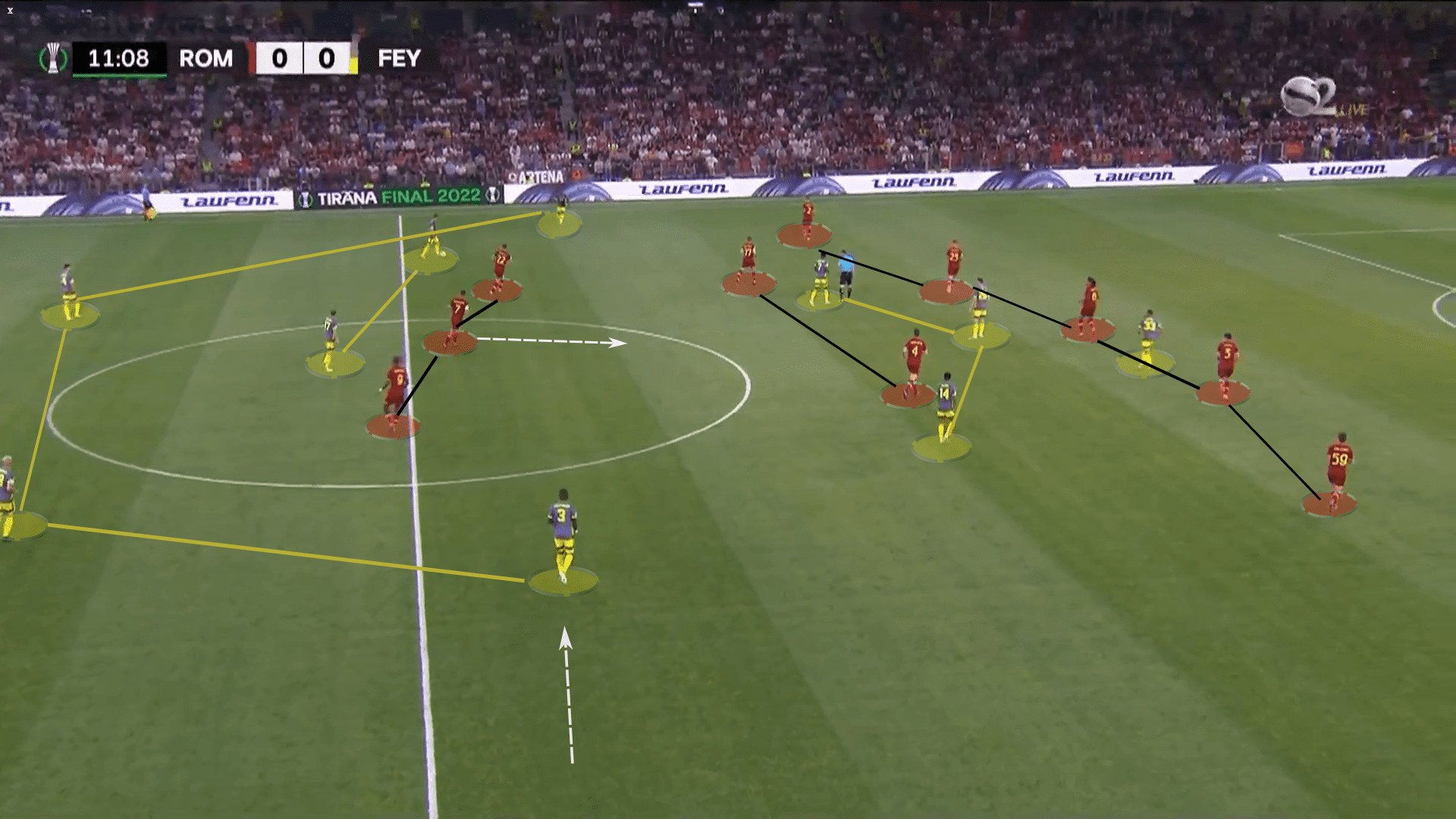
Structures
Roma utilized a conventional 3-2 build-up. They deployed a 3-4-2-1 shape in possession with Zaniolo and Pellegrini the half-space wingers, and Zalewski/Karsdorp as overlapping, orthodox wingbacks. Roma began the game aggressively with their defensive line relatively high. Feyenoord looked to press the three centre-backs man to man, while also covering the double pivot. This forced the Italian side to play longer balls toward Abraham as they could not sustain long spells of possession. One surprising aspect was that when Roma lost possession, they counterpressed immediately to try and recapture the ball, an approach not common with Mourinho sides.
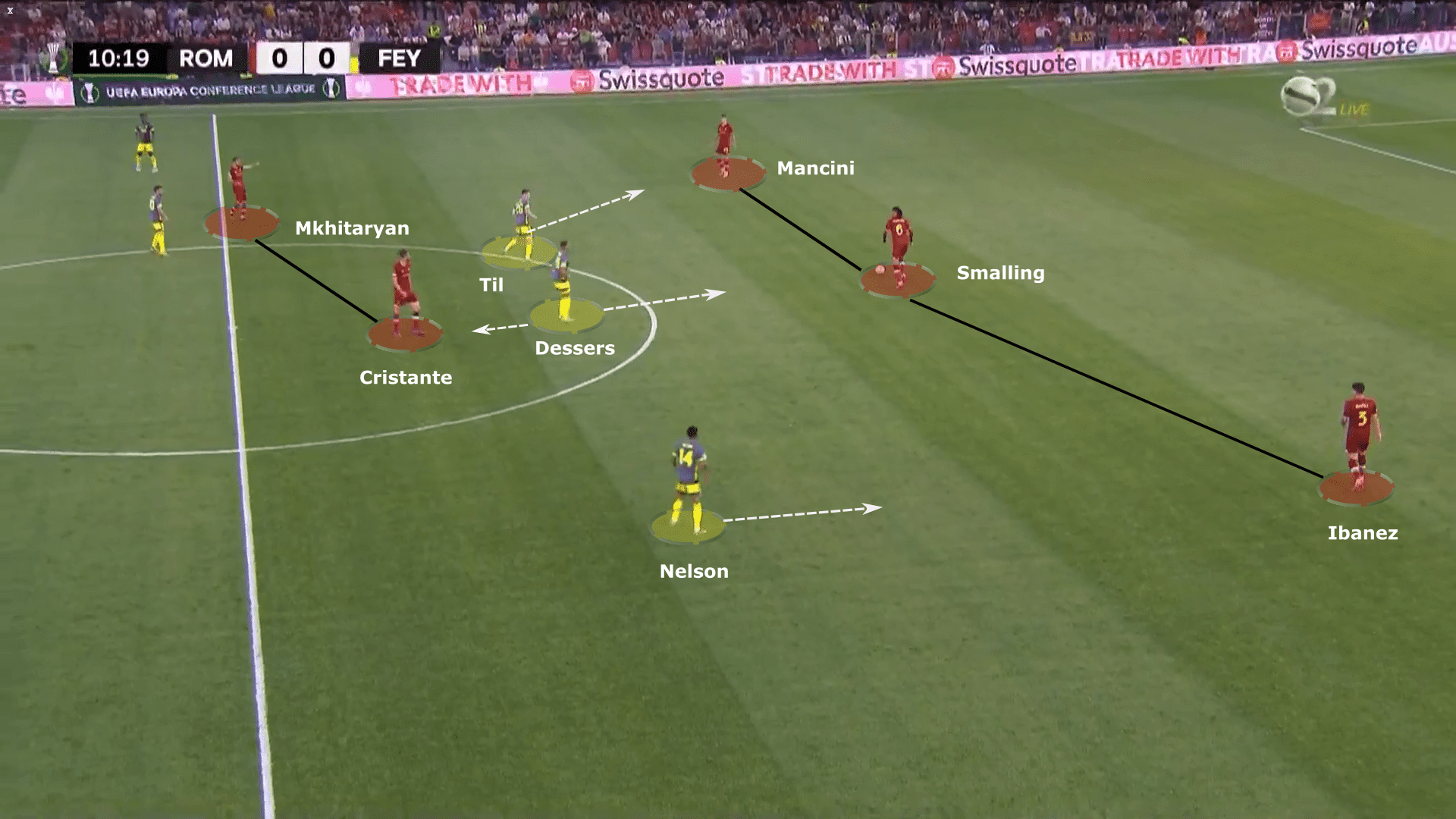
Feyenoord had a distinguishable approach relative to Roma. In possession, it looked like a 4-3-3, a model Dutch system. They tried to match Roma’s usage of wingbacks by having Geertruida and Malacia positioned high up the pitch in an attempt to stretch the opposition. Trauner and Senesi split wide. it was usually Abraham and Zaniolo who closed down the centre-backs while Pellegrini shadowed Aursnes. This meant that it fell to either wingback Karsdorp or Mkhitaryan to close down Kökçü, depending on the midfielder’s position.
Roma pressed with vigour initially, but Feyenoord seemed rarely phased, and could regularly find the extra man to escape the pressure.
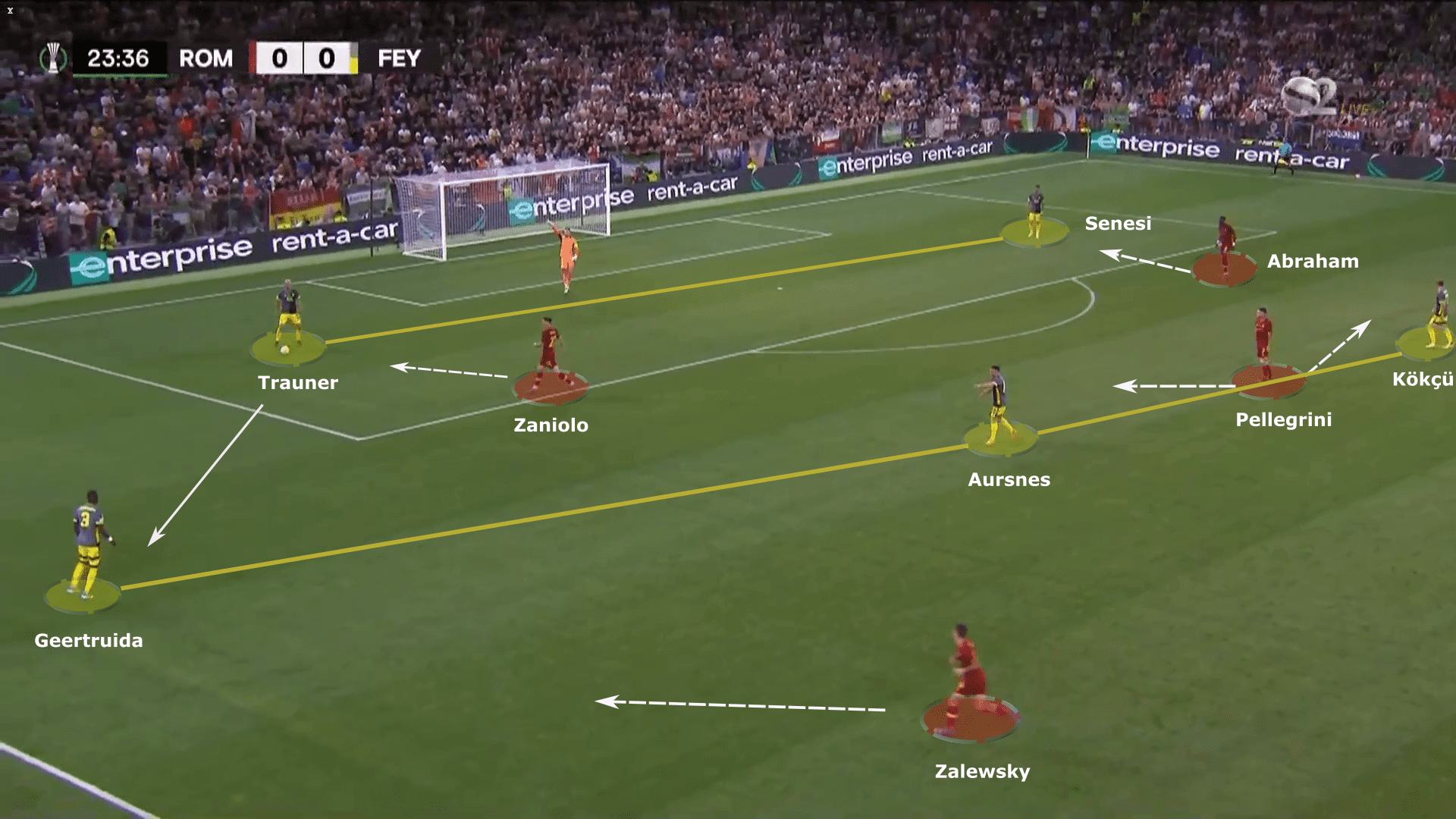
One of Roma’s main weaknesses in the semi-final against Leicester City was getting outnumbered in the middle of the park. On Wednesday night, Pellegrini tracked back to drop into midfield and support the double pivot of Cristante and Mkhitaryan/Sergio to prevent overloads. That was a key aspect of how Mourinho’s men gained control in the first half.
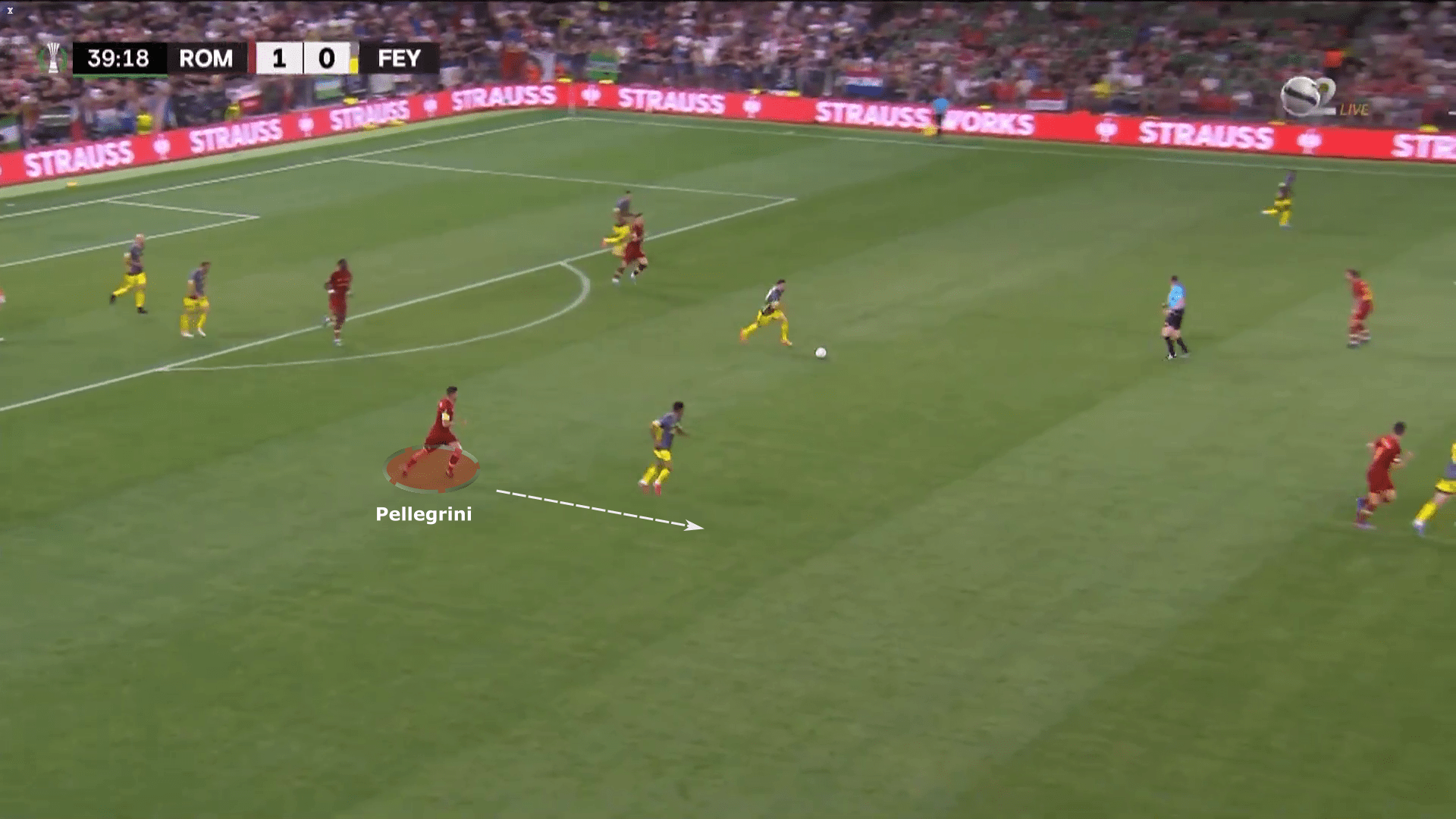
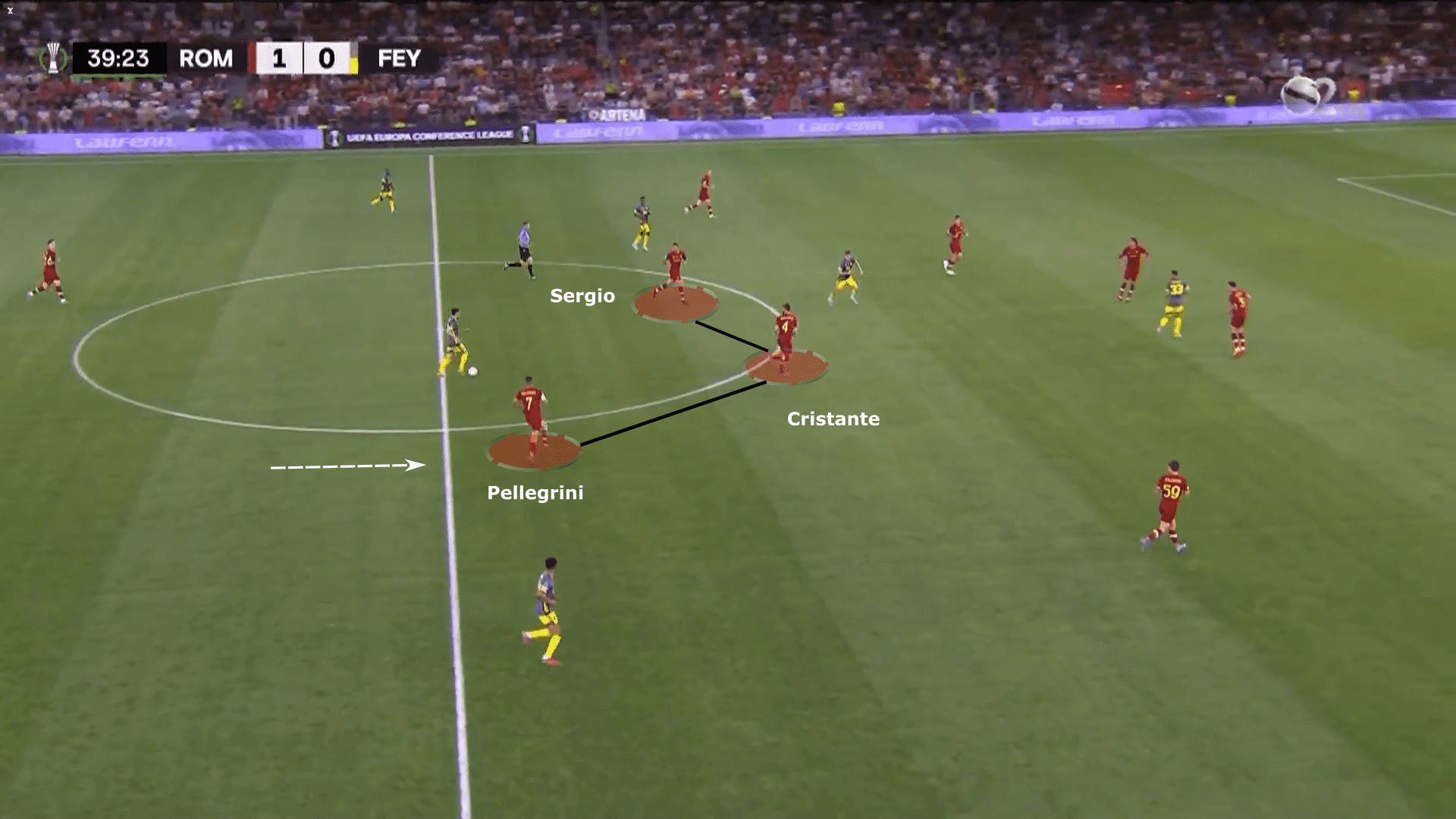
From goal-kicks, Smalling would form a triangular shape with Ibanez and Mancini, as an outlet to create more penetration against Feyenoord’s first wave of pressure. This was a replica of Mourinho’s mechanism against Leicester in the semi-finals. Feyenoord’s 4-2-3-1 shape with a high line was able to stretch Roma. Abraham and Zaniolo are too wide apart from each other, making it difficult for them to connect.
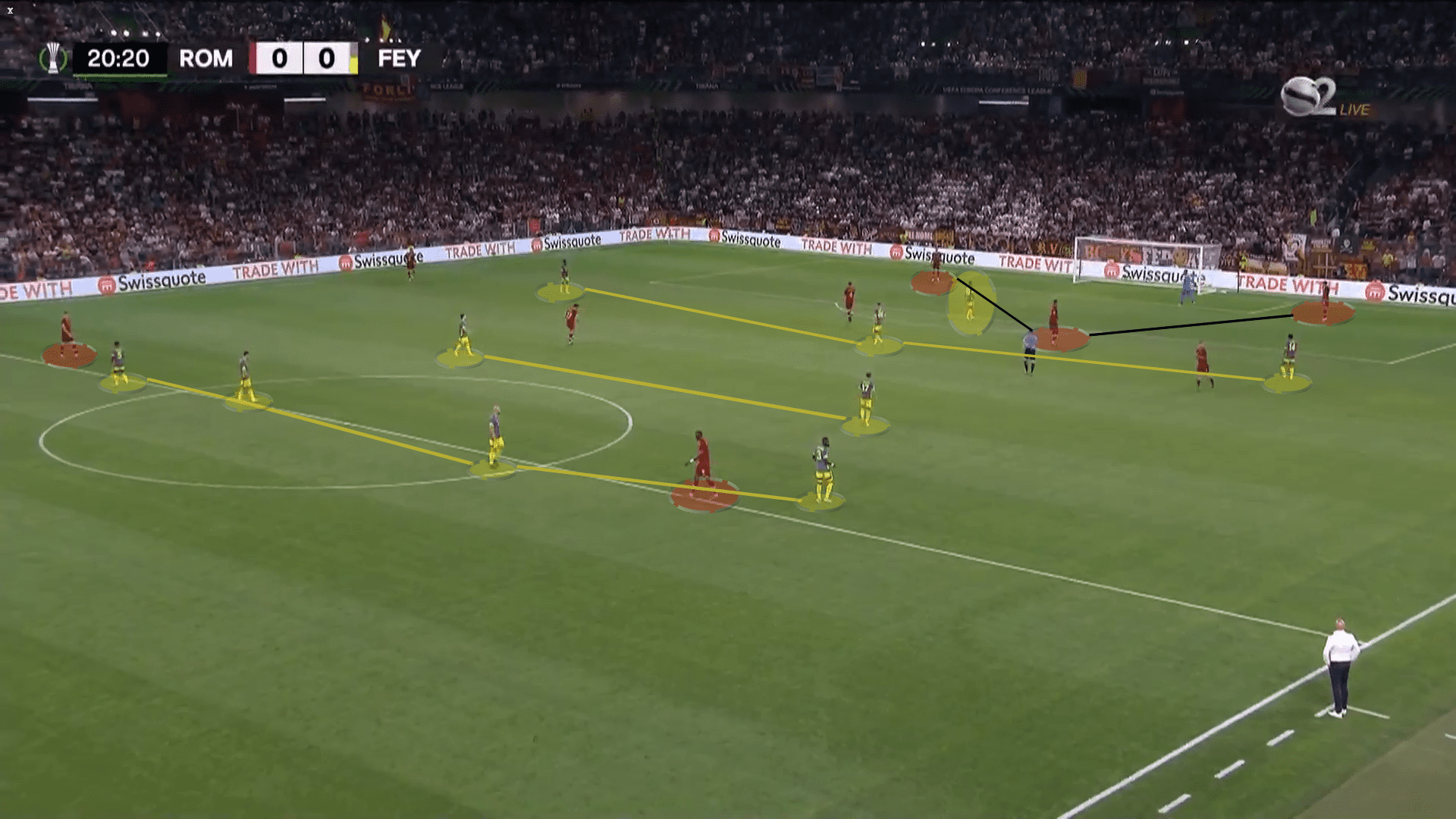
The game was very tactical in the early stages, with no team getting a sniff of goal. In fact, through the first 29 minutes, the two sides combined for only one shot on target. Roma were dealt an early blow when Mkhitaryan was injured and replaced by Sergio Oliveira, depriving them of one of their main creative sparks.
Goal
The game’s decisive moment, Zaniolo’s historic goal.
The positioning of Roma’s wingbacks was key to the team’s attacking structure. The open spaces offered to Karsdorp and Zalewski proved an issue that the Eredivisie side never truly solved in the first half. The pair did not make major attacking contributions, but their positions high up the pitch forced Feyenoord to cover them deeper.
At the instance of the goal, the Dutch team have 10 men behind the ball. This was part of the reason why Mancini was afforded time and space to pick out Zaniolo. His lofted cross slightly glanced the head of Trauner, but Zaniolo was quick on his feet, able to chest the ball down and swiftly dink it over the surging Bijlow in goal.
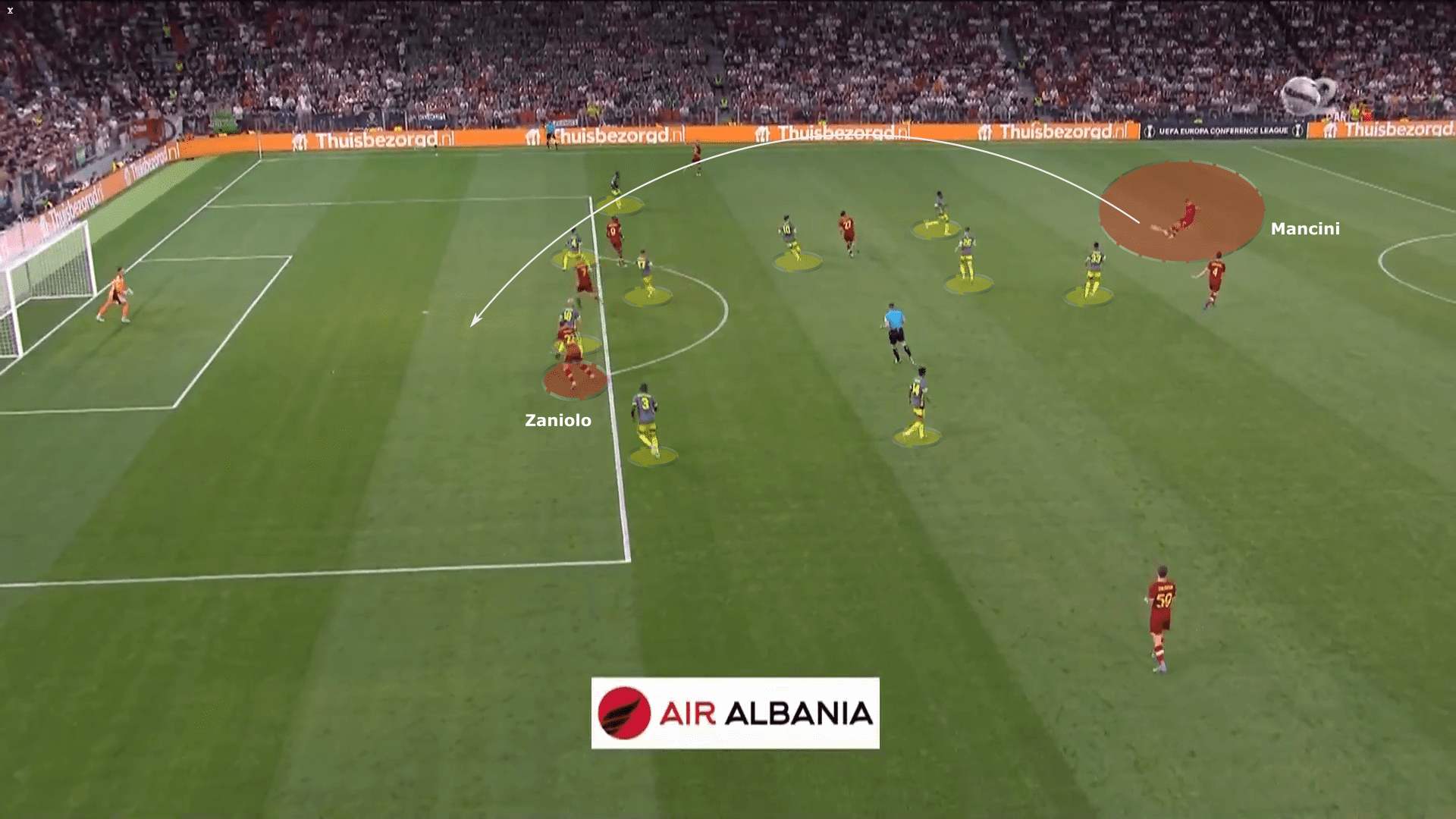
The 22-year-old became the youngest Italian player to find the back of the net in a European final since Alessandro Del Piero’s strike for Juventus against Borussia Dortmund in 1997. After suffering ACL tears to both knees in 2020 and enduring months on the treatment table, it was a fitting moment for the young star to guide his club to European glory.
Roma’s bench and fans went ecstatic with their celebrations, but Mourinho – the coolest man in the stadium – urged his bench to calm down knowing how much time was still left on the clock.
Feyenoord’s second-half tweaks
Despite dominating possession 62% – 38% in the first half, Feyenoord could not break through Roma’s stern defensive structure. Their patterns of passing were too slow and sometimes they would overcook the situation by playing a pass too many. The team lacked the necessary penetration and aggression required in a major final.
During the first half, Geertruida was drifting inside and basically playing as a third midfielder. This action left Nelson 1v1 with Zalewski in the wide channel.
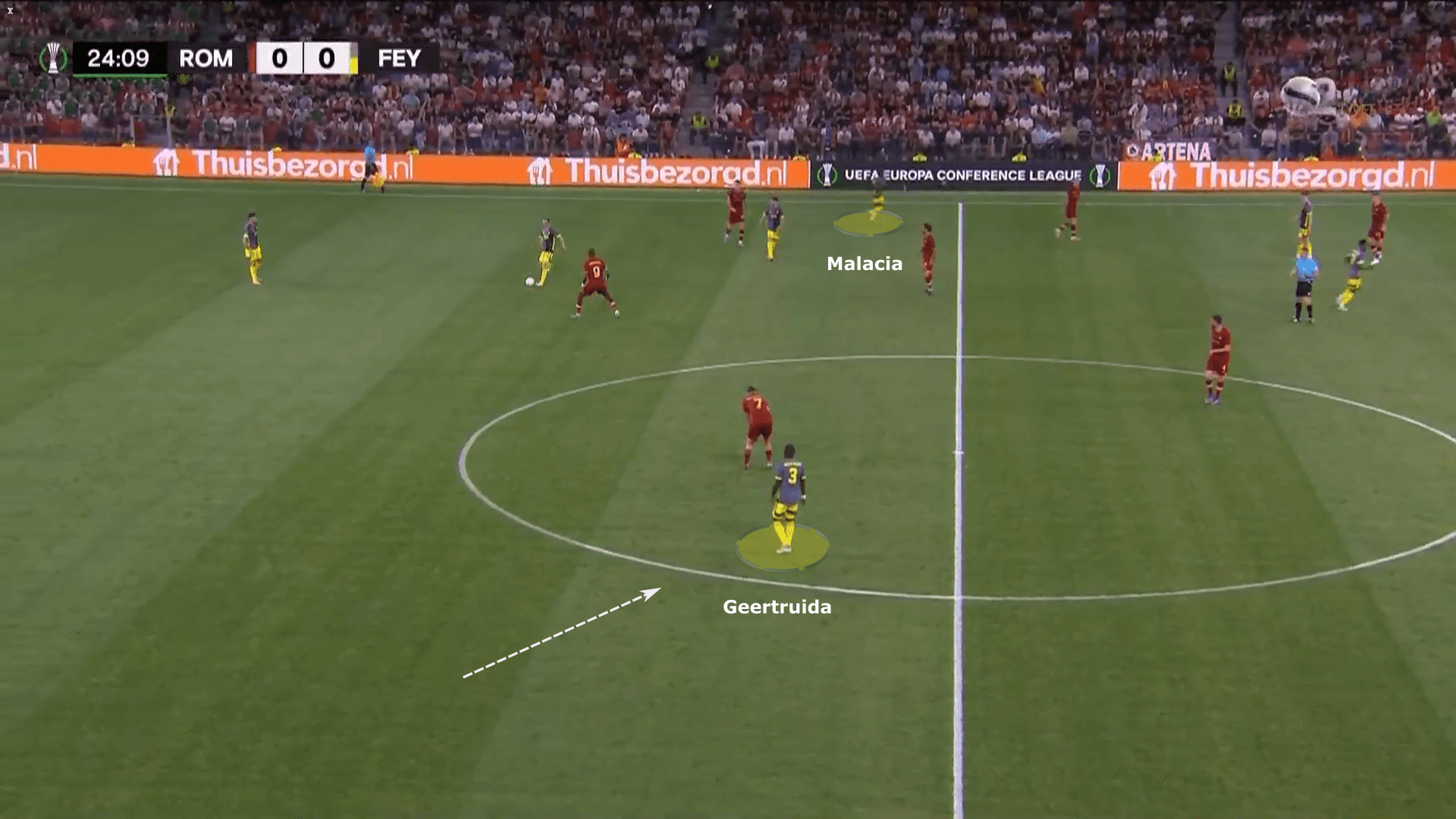
Geertruida’s positioning attracted Cristante towards him after receiving the ball while the attackers pinned Roma’s back three towards their box. This created a big gap in midfield for Nelson to exploit as he receives Geertruida’s pass on the cut-in. However, Feyenoord found it tough to create many of these openings during the first half as the Italian outfit was able to adjust.
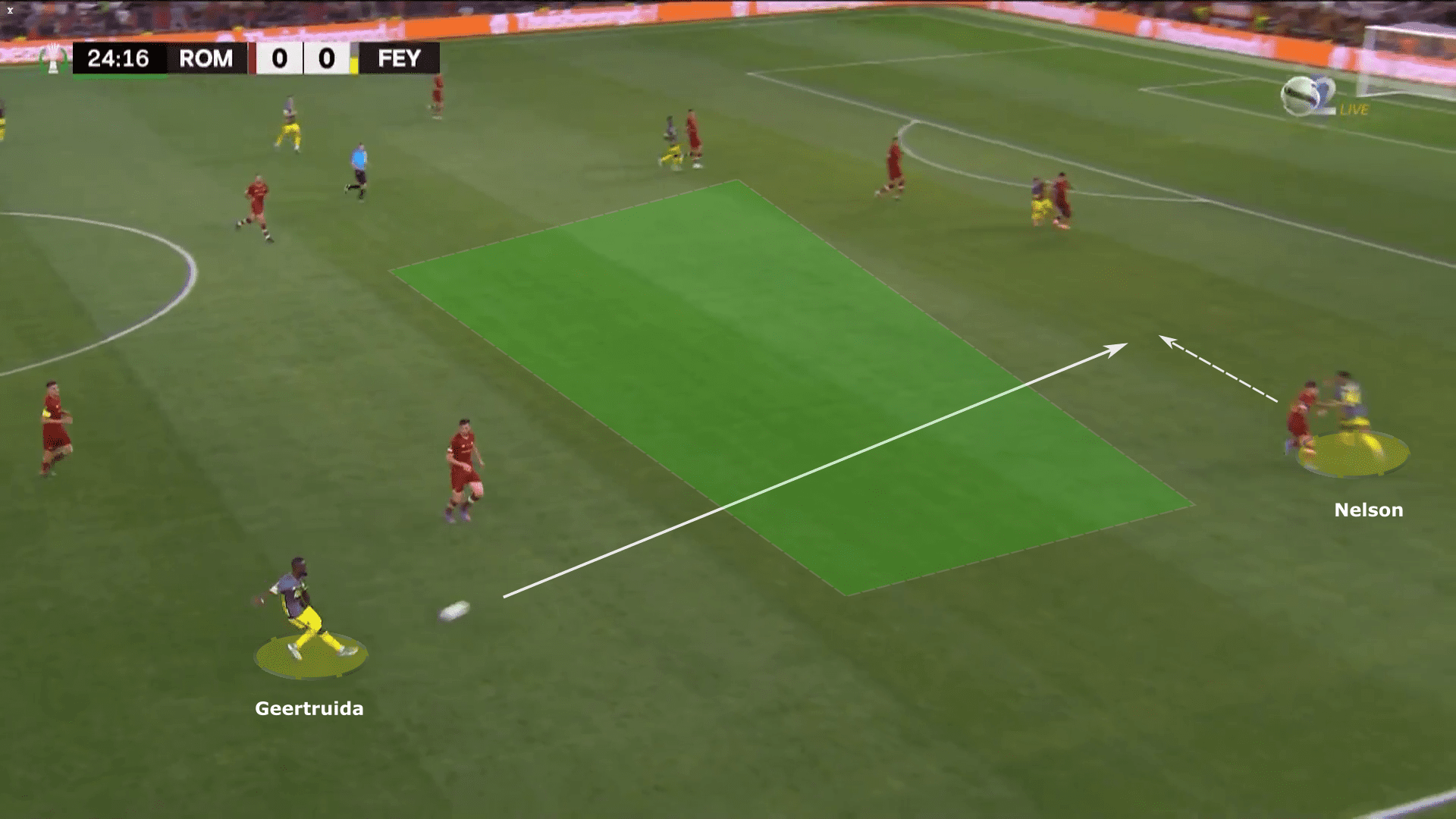
With 45 minutes left to save their season, Feyenoord returned to the pitch and proceeded to ramp up the pace. The main change was that the wings became occupied by just one player, and both full-backs began inverting and underlapping; flooding the midfield with as many as five players.
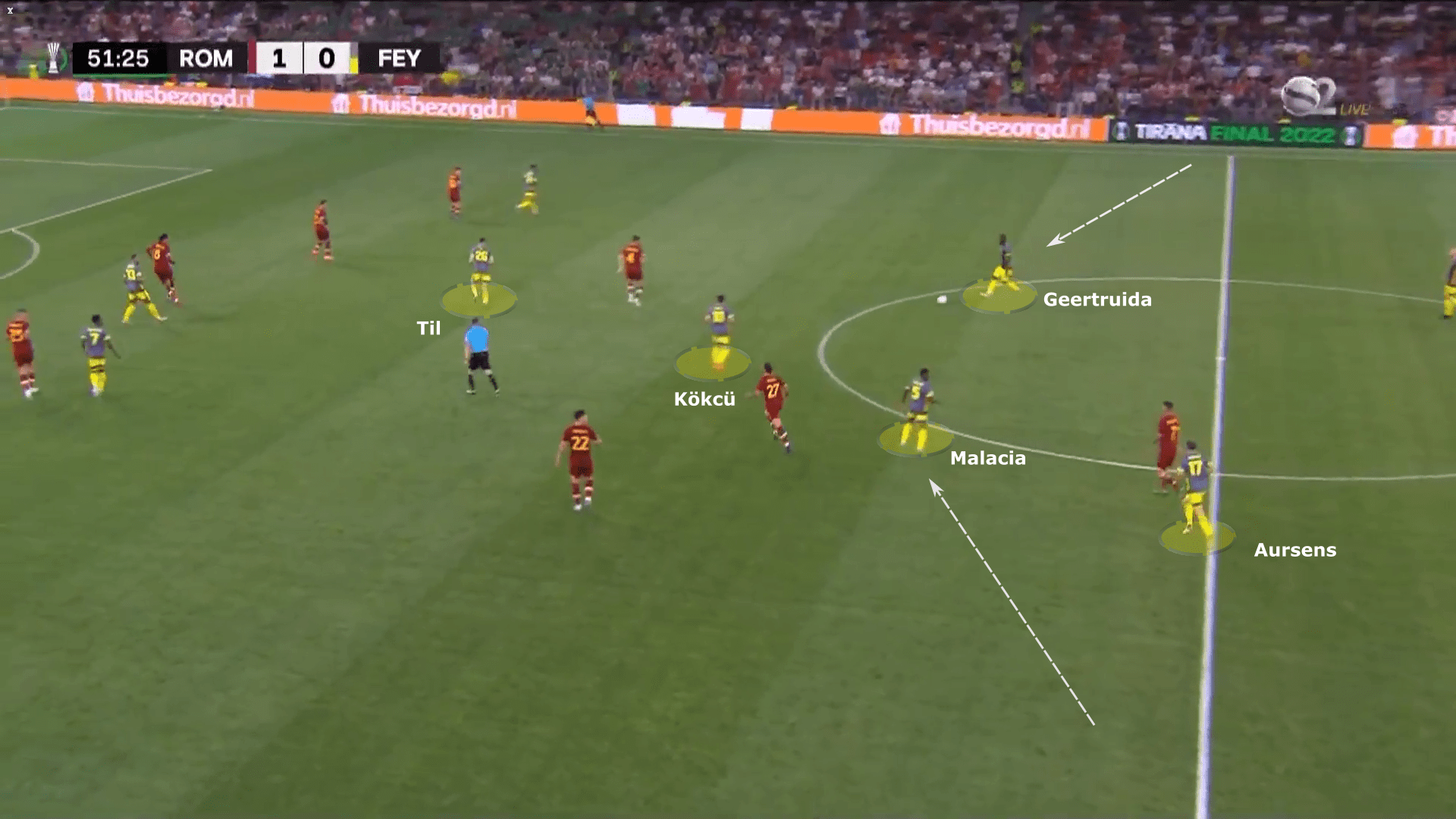
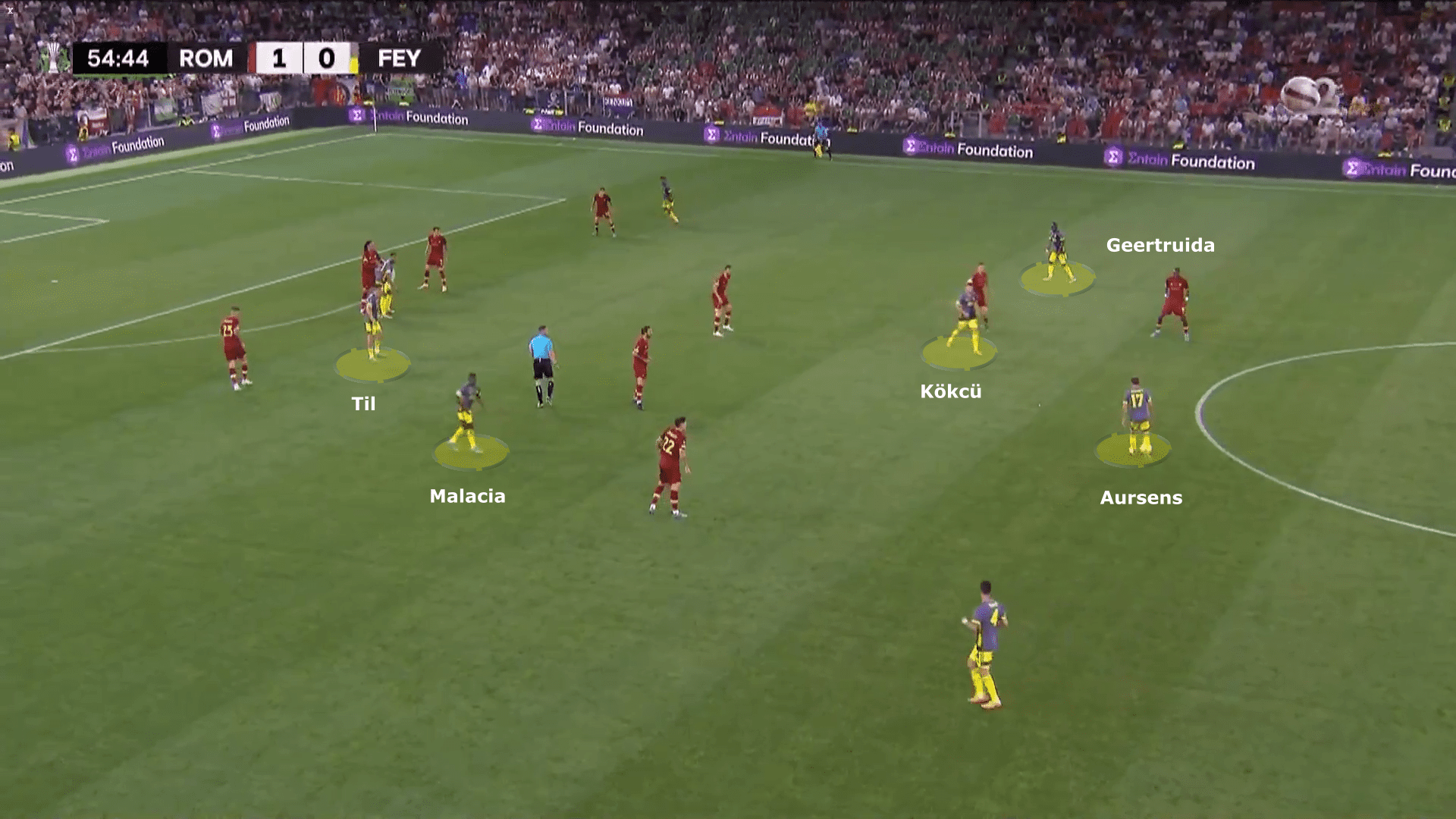
This tactic also prevented Roma to break from the middle, as they relied on counterattacks in the latter stages of the game. But the system was fluid in the sense that if Malacia went wide, Sinisterra would drop into the inside left channel. Feyenoord’s chance creation in the second half increased, and they began to sustain pressure more often from thereon. Roma were firmly up against it, with Feyenoord twice hitting the woodwork within the opening four minutes after the restart.
Progressive passes are a key part of Feyenoord’s attacking system. They are constantly looking to break defensive lines through their movement and positioning.
The movement of Dessers and Sinisterra, making runs between Mancini, Smalling and Ibanez stretched the pitch and afforded Feyenoord more room in midfield, while also pinning back the defensive line. The long ball into the channels was effective, as the Dutch’s side front players were able to outpace their opponents.
Trauner finds Kökcü in space, he lifts his head up and spots Sinisterra’s diagonal run inside across Ibanez and sends a looping cross in the winger’s path.
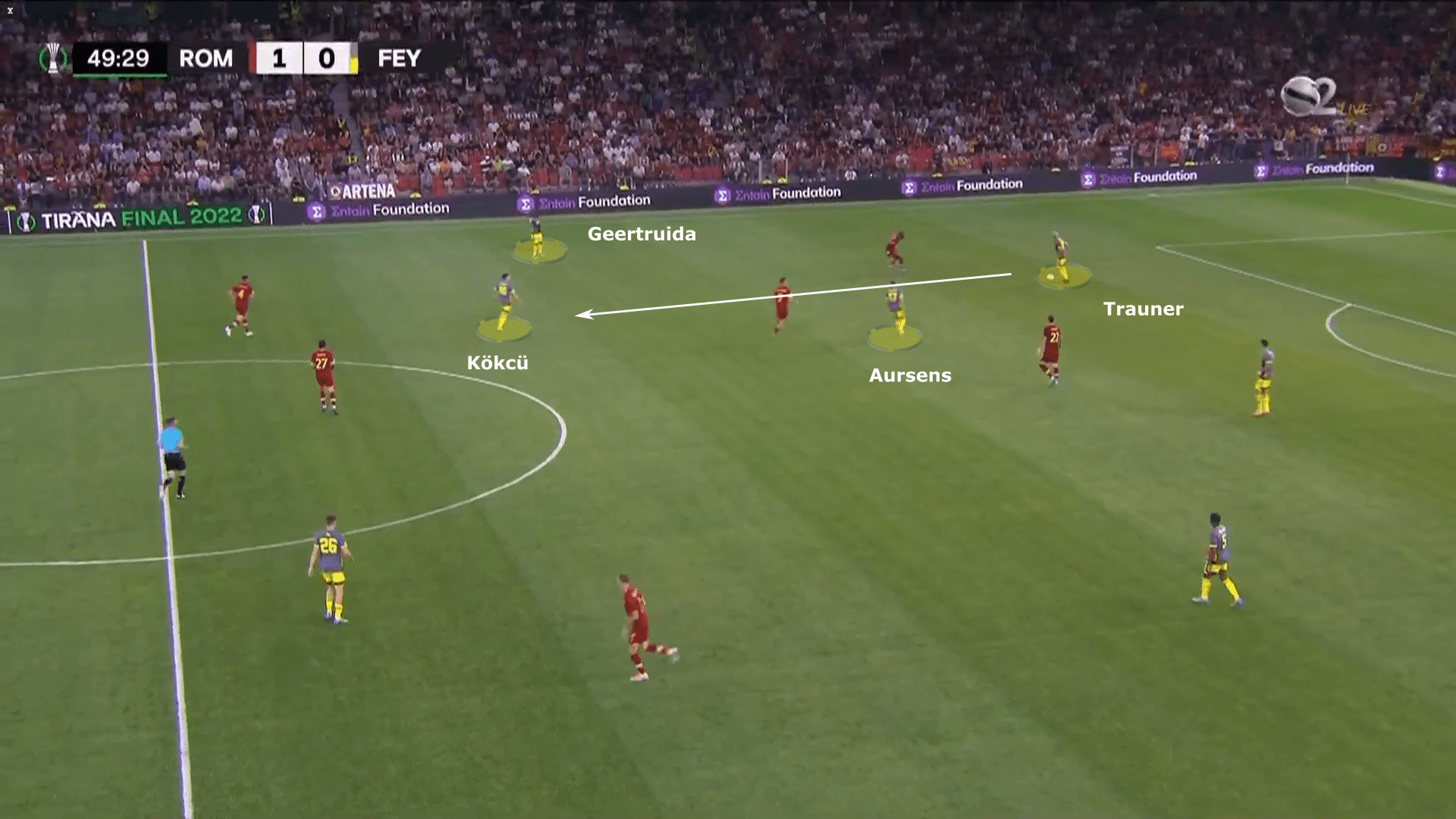
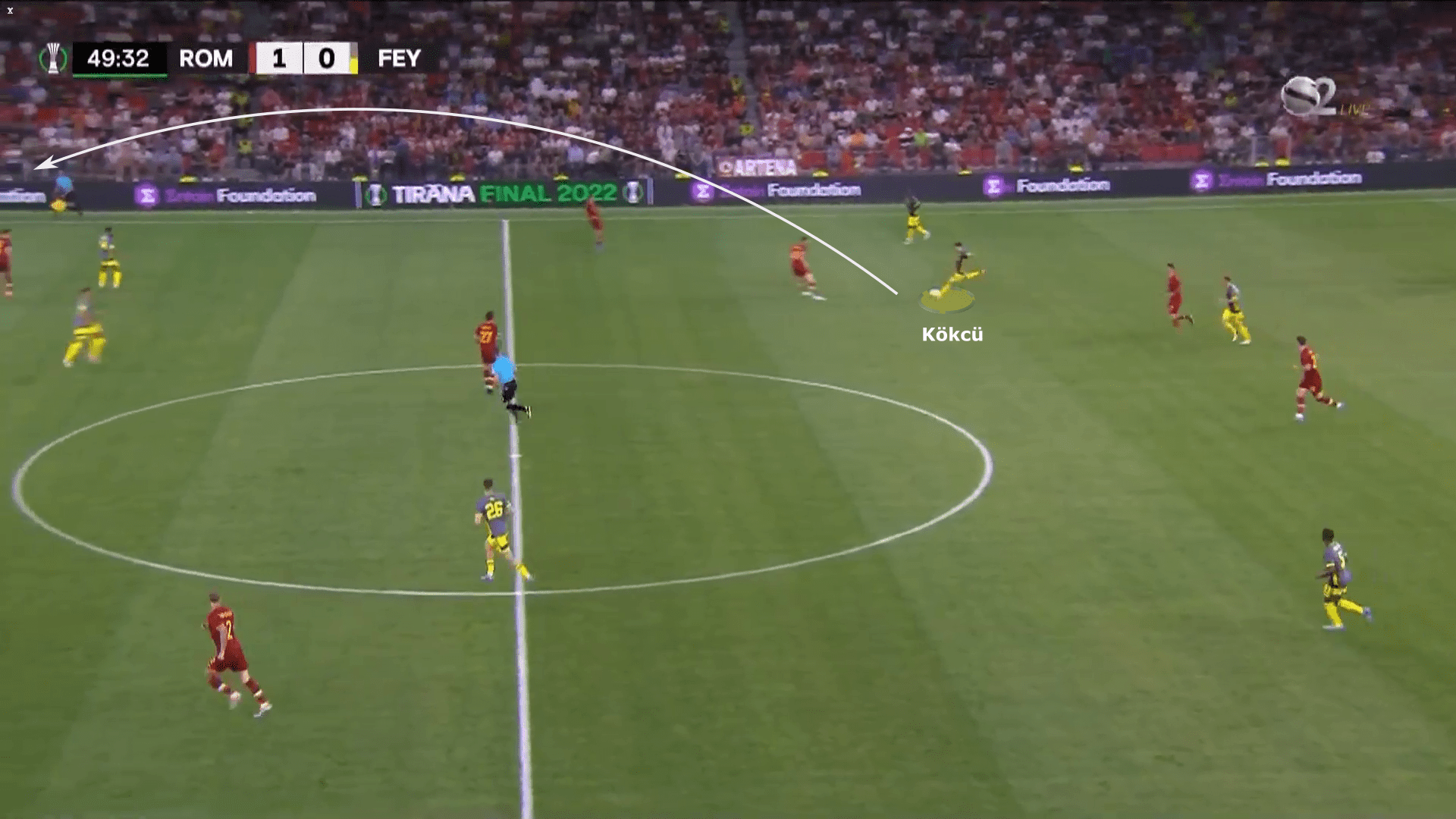
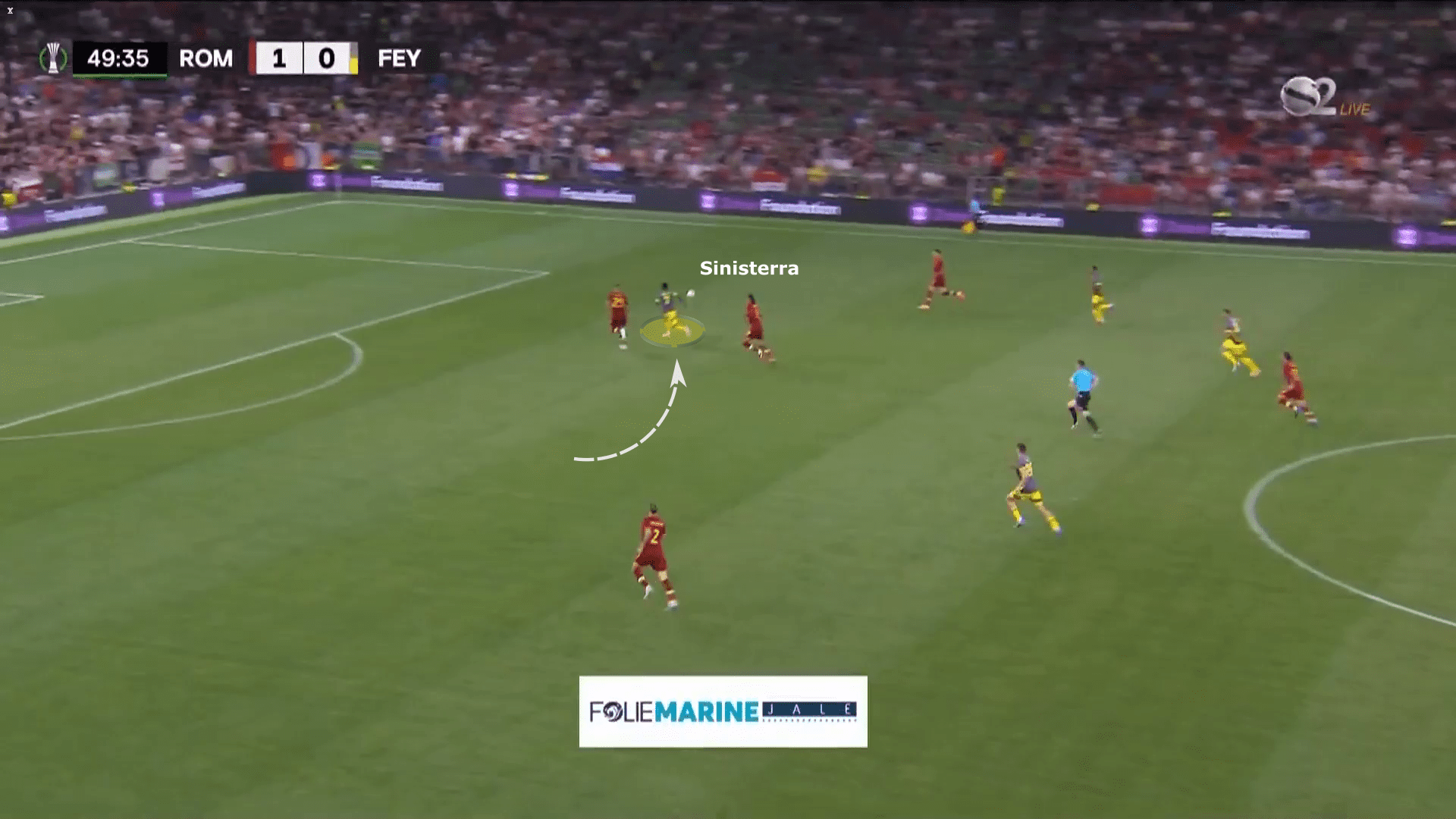
Sinisterra controls the ball, twists and turns; then plays an inviting ball towards the edge of the box. The attack ends up with Malacia’s fizzing strike parried by Patricio onto the crossbar.
There were times when Roma looked knackered, chasing after Feyenoord and their 66% share of possession. Roma became suffocated and could not get out of their own half. Their opponents intensified their pressing and forced the Italian side to hoof long balls forward just to escape the pressure.
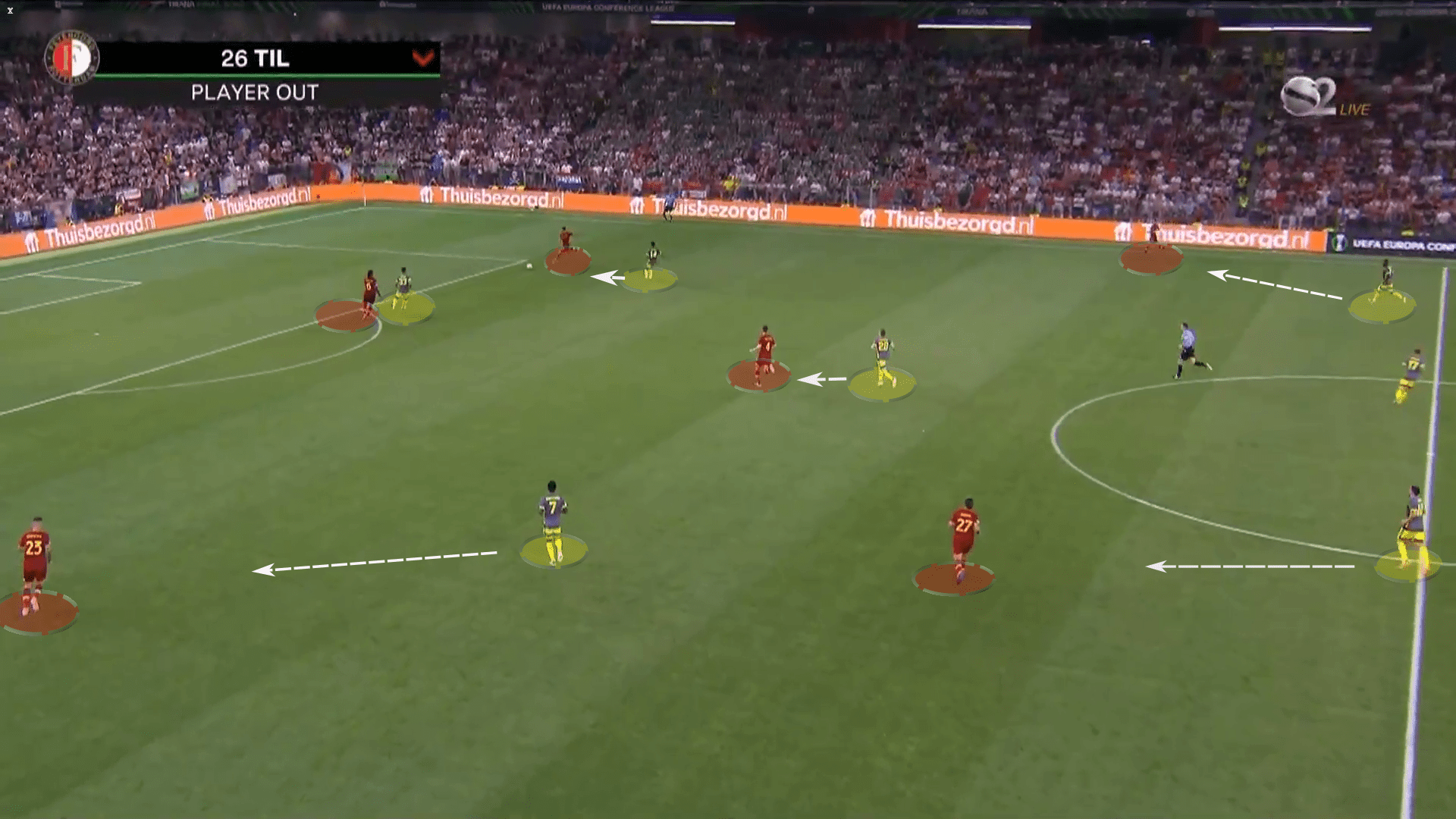
Noticing that his team was defending against waves of attacks, Mourinho made two substitutions: Spinazzola took over for Zalewski at left wingback, while Veretout replaced Zaniolo to stack up the midfield. Roma dropped back in a 4-3-3 to see out the game, with the interiors generally compact and narrow, however, they would pin wide depending on which direction the ball was being shifted to horizontally.
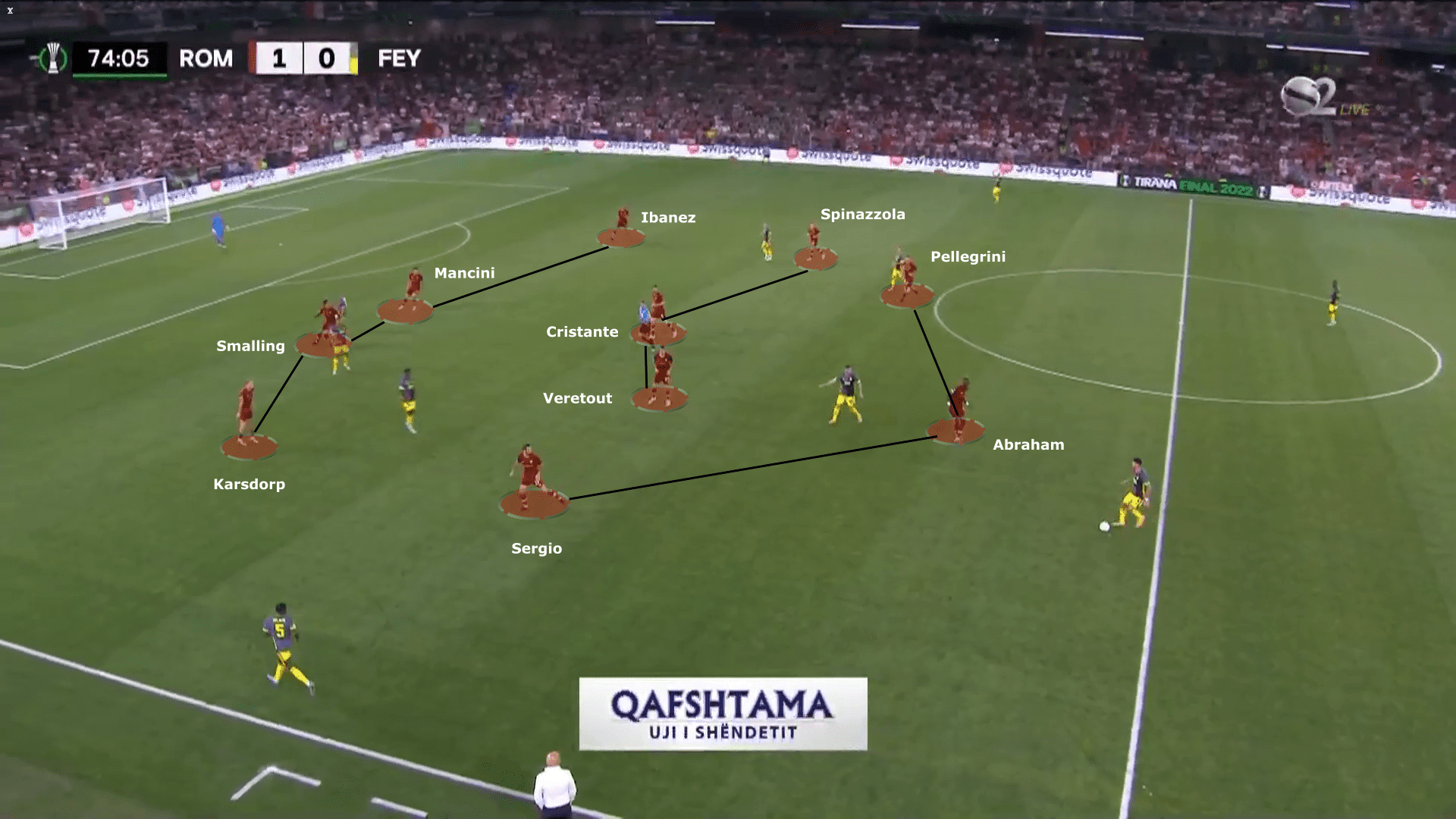
“I told the players during the break what they had to do better. In the second half we were sharp from the first moment, but you need a bit of luck and we didn’t get it. We had the time and opportunity to score, and we didn’t. Maybe that’s to do with the quality of the opponent.” said Slot after the game.
“In a final, you don’t get tens of chances, you get a couple. In a final against an Italian team, it’s especially difficult to create chances, and even more so when it’s an Italian team coached by Mourinho.”
It was a typical Mourinho display: take an early lead then defend, defend, defend.
Smalling MOTM
During the entire evening, Smalling’s positioning, anticipation, pace and strength were all on display to drive the competition’s top scorer to distraction. The former Manchester United man repeatedly kept Dessers at bay. With 4 duels and 6 loose balls won, 7 interceptions, 13 recoveries and 4 clearances; Smalling will travel back to Rome with a Conference League medal around his neck and a man of the match award in his grasp.
Smalling was able to deal with high balls and crosses as well as balls to the feet of the Feyenoord attackers.
With a long ball arriving from the back, Smalling coolly outmuscles Dessers and manages to clear it away.
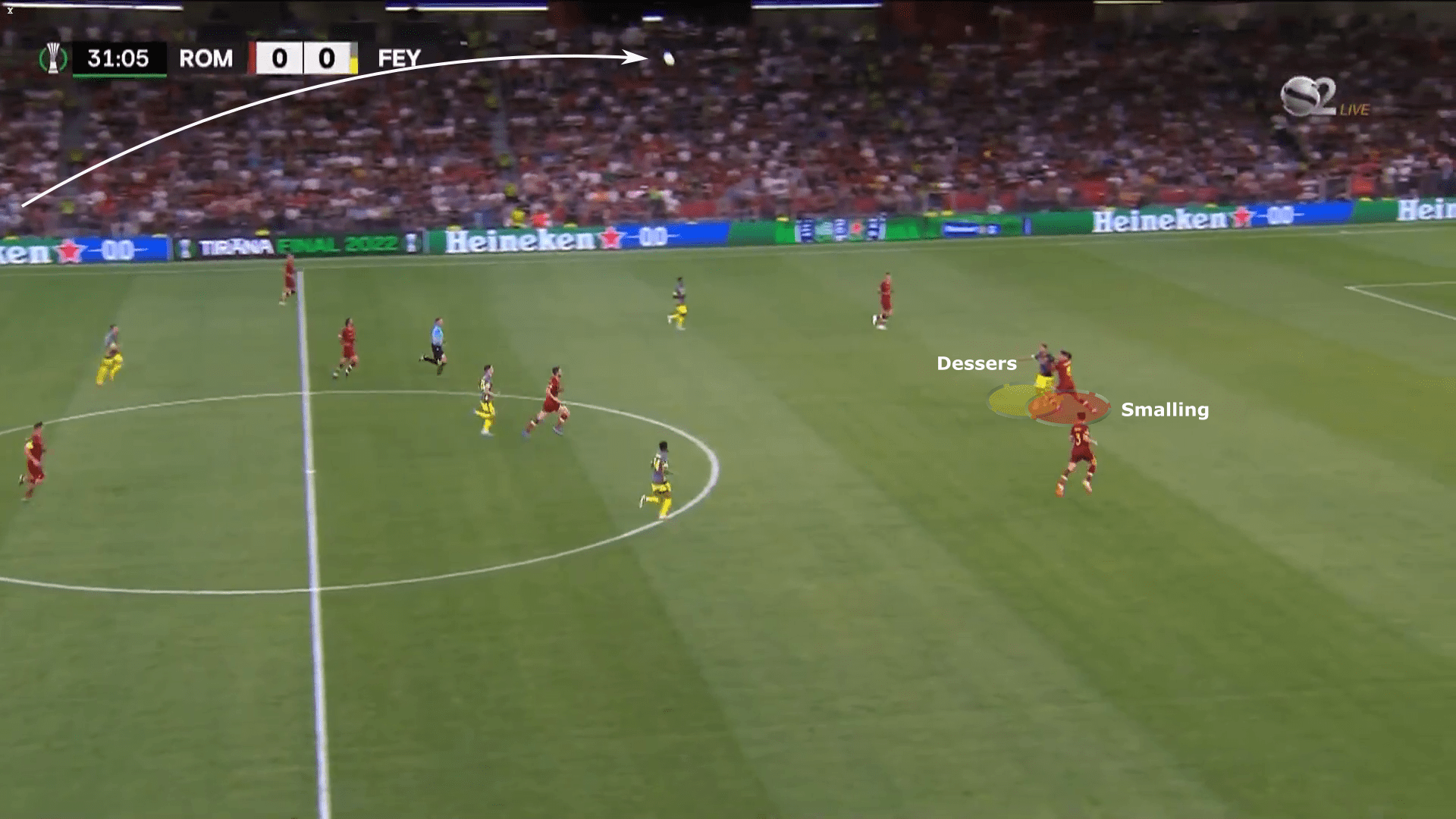
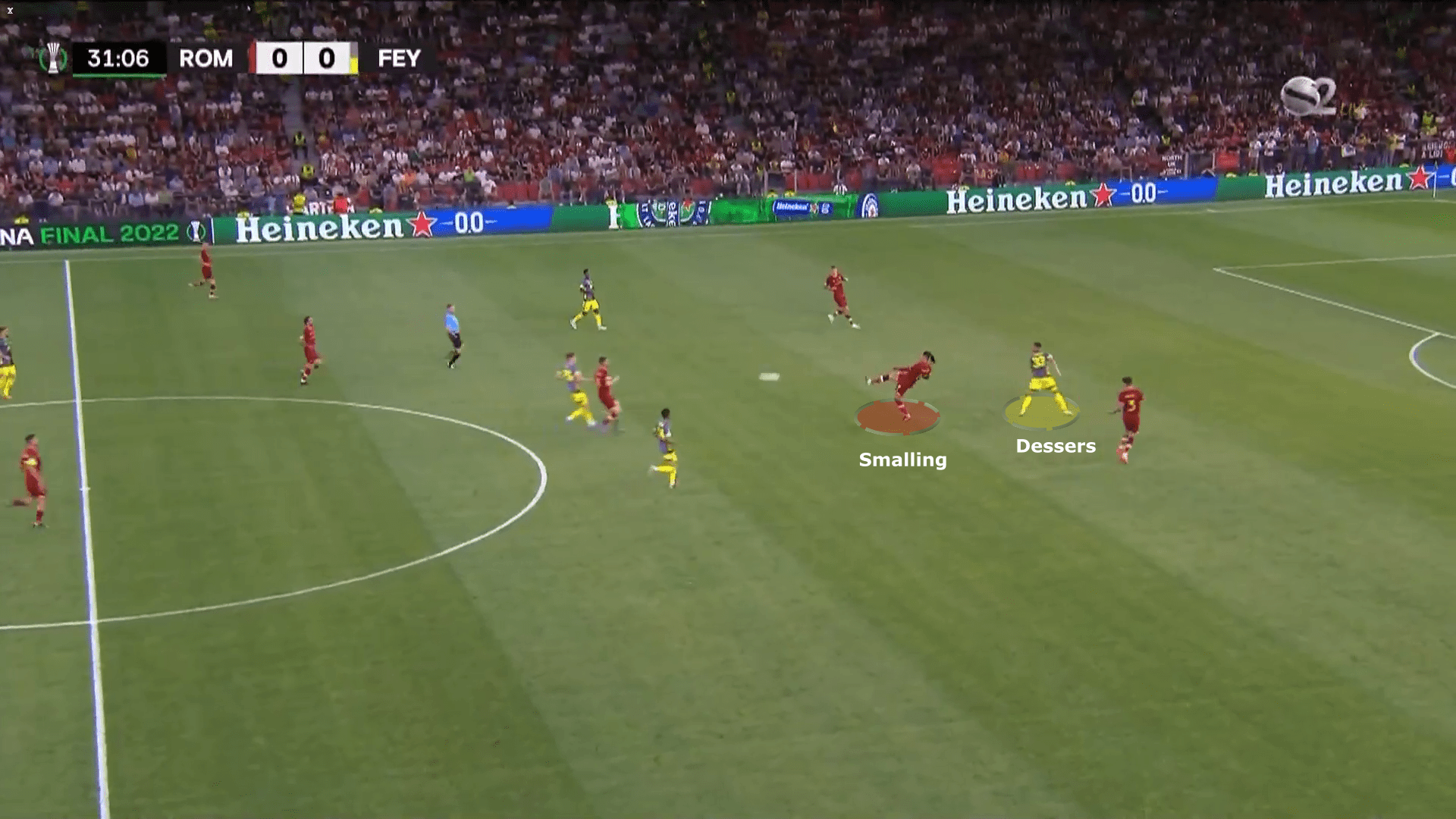
Dessers was playing with his back to the Englishman, looking to exploit the spaces on either side. But Smalling had the awareness, physicality and desire to get first to every ball.
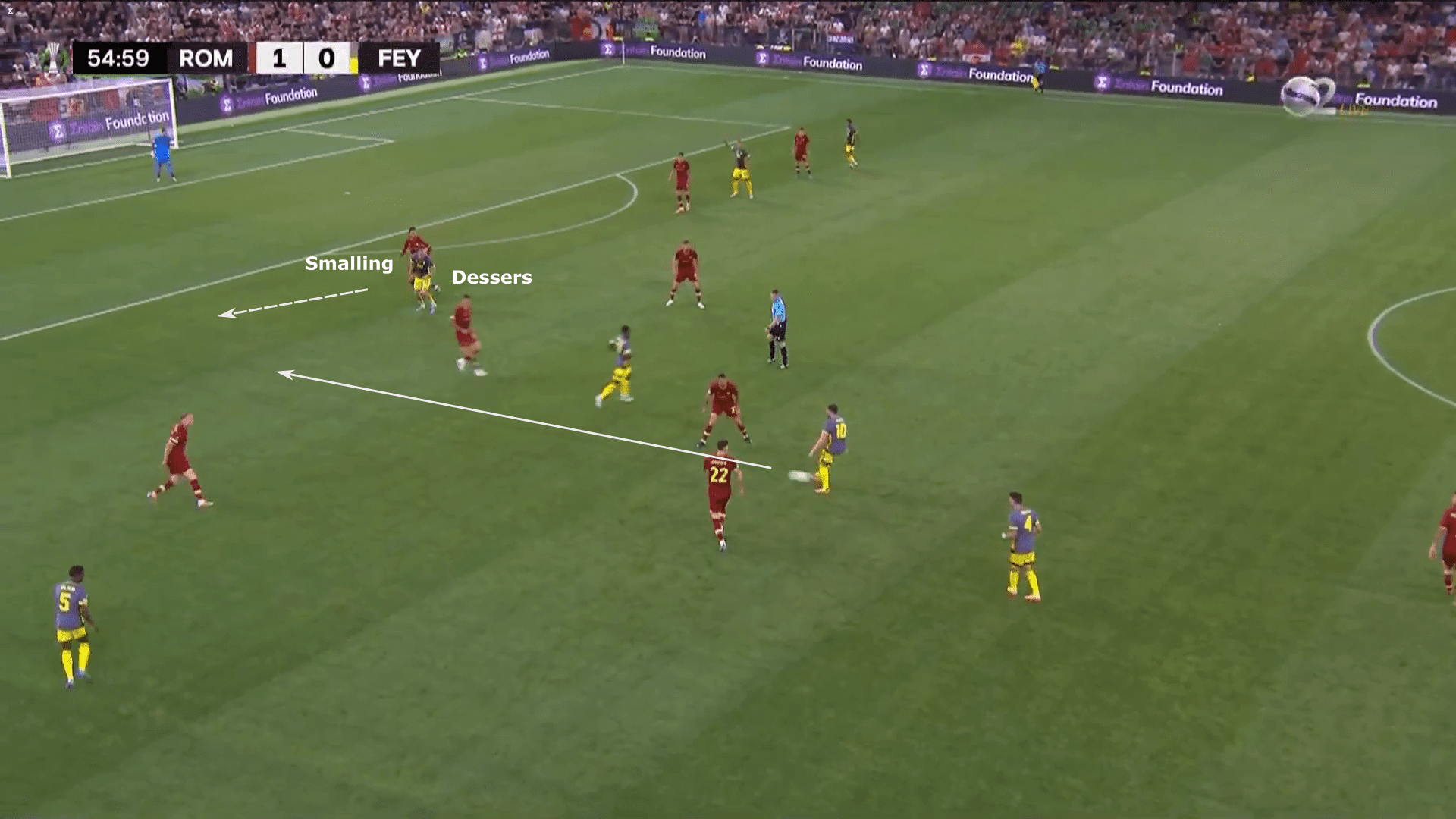
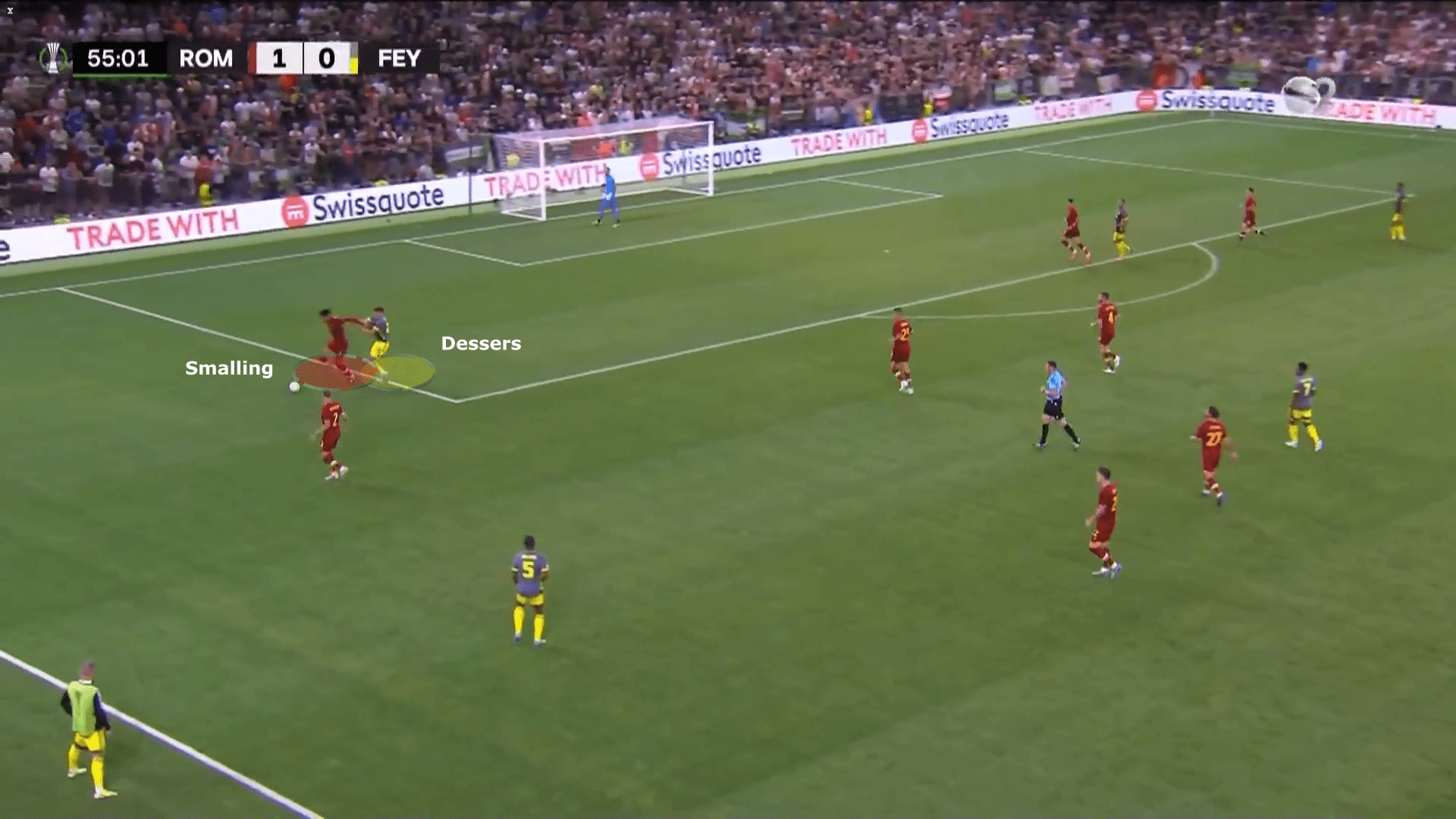
Disappointed by his team’s loss, Dessers has voiced his displeasure at a perceived physical, rough, and negative football from Roma.
“I was always against three defenders and if I won one duel, then the next was already there. They were also all a lot bigger. Chris Smalling has become the man of the match for a reason. He especially made it very difficult for me today.” stated Dessers post-match.
This perfectly encapsulated the win at all costs mentality that Mourinho has instilled into this Roma side.
Conclusion
xG: Roma 0.41 – Feyenoord 0.58
Passes completed: Roma 263 – Feyenoord 578
Possession: Roma 34% – Feyenoord 66%
Feyenoord had the edge in all three key stats during the game but came up short in the end. This shows that stats do not paint the whole picture. A phrase Mourinho has repeated hundreds of times during his career. Arne Slot can be proud of his team’s efforts; ultimately they just faced a more experienced team with a manager who has winning in his DNA.
Teams coached by the Portuguese have now gone 423 minutes since last conceding in a major European final (since 2003). Mourinho-led sides have kept four consecutive clean sheets since.
“Today wasn’t work,” head coach Jose Mourinho said tearfully. “It was history, and we wrote it.”
These words, by a man who has won the biggest honors in the game, vindicate UEFA’s decision to form the Europa Conference League. Sure, the quality might not be top tier, but it gives teams a chance to compete in European competition, gain invaluable experience and create their own fairy tale.

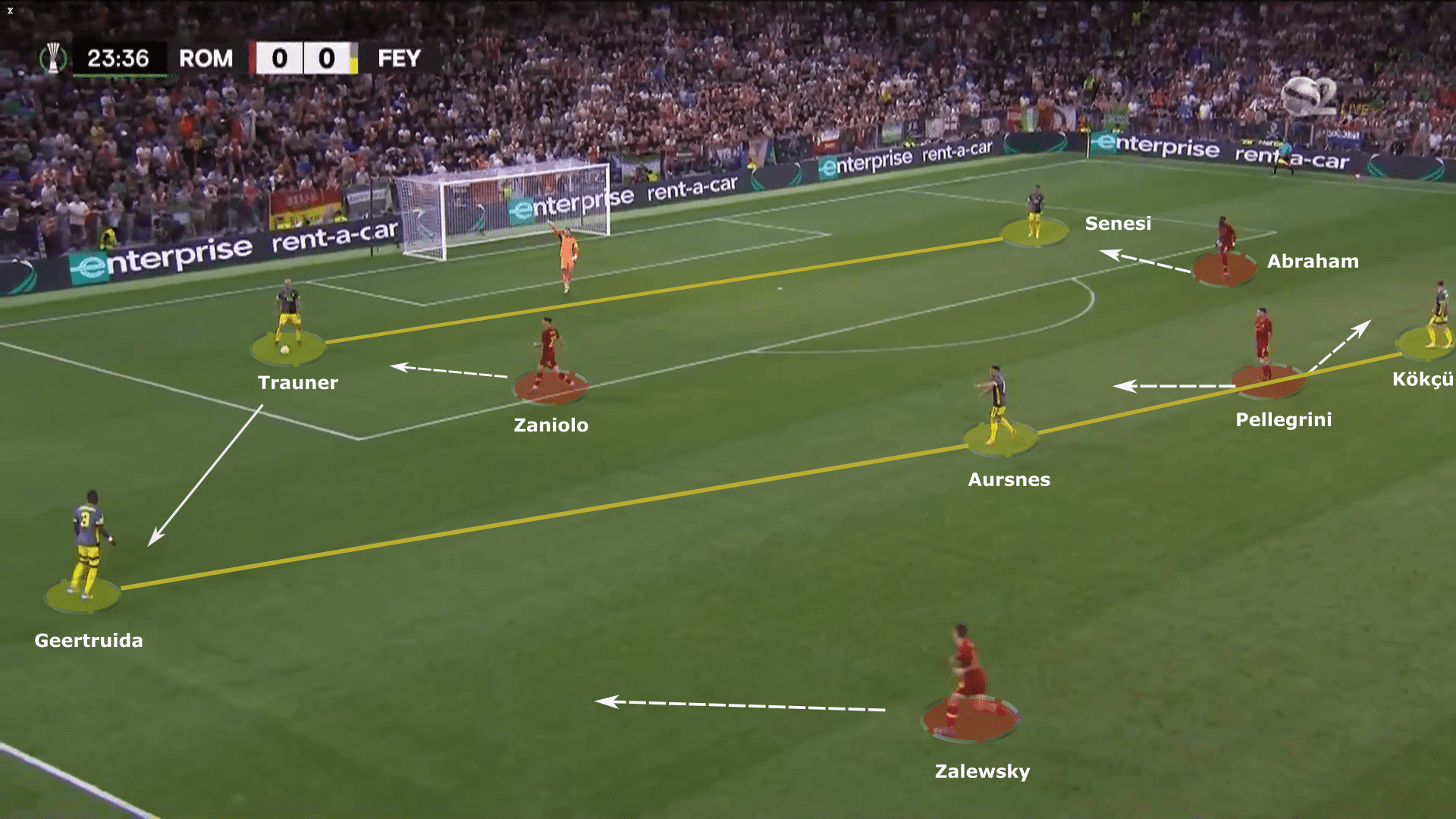



Comments